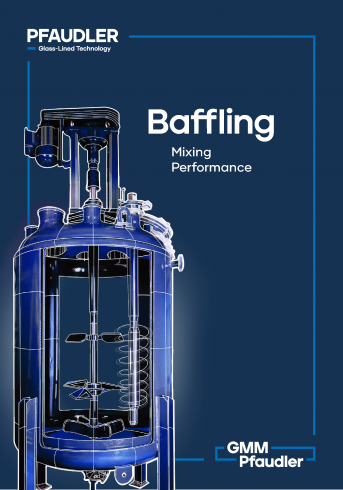Baffling Technology
Pfaudler - Glass-Lined & Alloy Systems
Technologies

What is the purpose of a baffle?
In a stirred reactor, the agitator generates a rotating movement of the fluid mass. In the absence of a baffle, a vortex builds up. The agitating power input into the fluid mass is reduced to a minimum. The baffling degree is per definition 0.
In case of four wall baffles at 90°, as frequently found in stainless steel vessels, the agitating power input is maximized. Increasing the number of baffles will not increase the power input. The baffling degree is per definition 1. The flow pattern is said to be “fully achieved”, or the reactor is “fully baffled”.
The main purpose of a baffle is to increase the agitating power input, in order to move towards a fully achieved flow pattern.
In low and medium viscosity ranges, baffles are generally very helpful. Nevertheless, some rare processes run without baffles.
At higher viscosity ranges, the impact of baffles can be negative, since they may create dead zones behind and in front of them, resulting in agglomerates or poor product quality.
In crystallization processes, baffles with too high baffling degrees may adversely affect crystal sizes and homogeneity. In polymerization processes, turning baffles may be useful since the flow incidence angle affects product quality.
Sometimes, baffles are used as additional surfaces for heating or cooling. Consequently, baffling designs need to be flexible, customized case by case to process requirements. Fixed baffling is detrimental to the optimal multipurpose use of reactors.
Increasing the power input, and a lot more.
In addition to its main task of increasing the agitating power input in the media, a baffle has many other purposes:
Temperature sensor carrier:
- ideal location of the temperature sensor at the low end of the baffle, at the core of the process
- away from any influence that could impact the accuracy of the measure, such as proximity to the jacket or half pipe wall or in an improperly agitated area
Corrosion-monitoring sensor carrier
Breaks up liquid surface
Diverts flow towards the wall or the centre
Baffles are wear parts
The life span of a glass-lined baffle is generally shorter than that of a glass-lined reactor. Baffles and other reactor internals, such as turbines, are stressed by flow velocities, solid suspension hits (erosion), frontal incidental flow vs. tangential flow for the vessel wall, and sometimes cavitation. High-efficiency baffles close to the wall undergo even higher stress and wear.
Therefore, a glass-lined baffle must be easily removable and replaceable. A baffle must be able to be re-glassed without having to dismantle the whole reactor.




